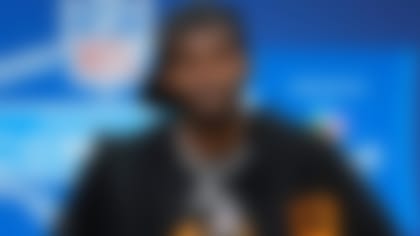The Baltimore Ravens last played in the Super Bowl 12 seasons ago. Many things have changed with the franchise over the past dozen years: New owner, new head coach, new players, new facility. However, one element has remained constant: the leadership, vision and guidance provided by Ravens general manager Ozzie Newsome.
I had the opportunity to work under Newsome for four seasons in the Baltimore personnel department, and I learned many valuable lessons during this period of time. I learned that it's important to build a team rather than just collect talent. I also learned the importance of adding tough-minded players. Ozzie always made a point to ask the important questions during NFL draft meetings. These were the two that he repeated most often:
1) "How will he fit in our locker room?"
2) "Does he help us beat the Pittsburgh Steelers?"
Newsome never got too carried away with height, weight or speed. He wanted football players. Period. That philosophy helps explain the makeup of this current Ravens roster.
What follows is an in-depth look at the key acquisitions that formed this Baltimore team. For a chronological look at the entire team makeup, scroll to the bottom of the page.
NFL draft selections
Ray Lewis, LB (1996) and Ed Reed, safety (2002): Lewis and Reed are both destined to be first-ballot Hall of Famers. It's hard to believe the Ravens were able to land both of these players so late in the first round (Lewis at No. 26 overall, Reed at 24) of their respective drafts. Both players slid in the draft primarily because of their lack of size. During draft meetings, the Ravens don't get hung up on size, choosing to focus more on playing speed, toughness and instincts. Lewis and Reed both scored off the charts in all three areas.
Terrell Suggs, LB (2003): I joined the Ravens personnel department immediately following the 2003 NFL Draft. I can remember Suggs causing some commotion in the building when he showed up a little bit too heavy during his first training camp. Fears about him were quickly erased, however, following his first one-on-one pass-rush repetition; everyone in the personnel department immediately realized that Ozzie had hit another home run. If not for a poor time in the 40-yard dash, Suggs likely would have been long gone before the Ravens had the opportunity to select him with the 10th overall pick. Once again, the Ravens benefited from the philosophy of taking the best football player, not the best "tester."
Haloti Ngata, DT (2006): I was in the Ravens' war room during the 2006 NFL Draft. We were looking for a big, athletic defensive tackle to help protect Lewis, someone who could also provide some interior pass rush, and we'd had our sights set on Ngata well over a month before draft day. When it looked like the Cleveland Browns might select Ngata one spot ahead of us, Ozzie made the call to send them a late draft pick in order to move up a spot and secure the talented defensive tackle from Oregon. Newsome believes a strong defense is built up the middle. With Ngata, we were set with elite players at defensive tackle, middle linebacker and free safety.
Marshal Yanda, OG (2007): Yanda was well regarded by every scout in the draft room. Ozzie had already selected an interior offensive lineman (Ben Grubbs) with our first-round pick, but Yanda was somehow still available late in the third round. During draft meetings that year, we spent a lot of time discussing the need to get more physical on the offensive line. We felt selecting both Grubbs and Yanda significantly upgraded the physicality of that unit. Yanda has proven to be one of the NFL's elite offensive linemen, while Grubbs is no longer with the team, having gone to the New Orleans Saints via free agency.
Joe Flacco, QB and Ray Rice, RB (2008): The 1996 NFL Draft will always be considered the best in Ravens franchise history, with two of the draftees that year, Jonathan Ogden and Lewis, going down as two of the best players ever to man their respective positions. However, the haul in 2008 has to be considered the second-most important Ravens draft class. Baltimore made a valiant effort to move up and select Boston College quarterback Matt Ryan, but after that failed, Ravens brass focused on the big-armed signal-caller from Delaware. After securing their franchise quarterback with the 18th overall pick, the Ravens looked for a dynamic three-down running back, grabbing Rice in the second round. I received a phone call from one Ravens scout following their first post-draft minicamp in 2008. He raved about Rice, saying they had just picked up Maurice Jones-Drew 2.0.
Ed Dickson, TE and Dennis Pitta, TE (2010): Some teams operate according to a needs-based draft philosophy. Newsome's Ravens don't. If two players share similar grades from the scouts, it might seem that it would make more sense to take the player who fits a need. However, Ozzie never jumps a lower-rated player over a higher-rated player just to fill a particular hole. The 2010 draft class was incredibly deep at the tight end position. Instead of selecting one, Newsome decided to secure two very talented players at the same position. This proved to be a very wise move.
Torrey Smith, WR (2011): In Flacco, the Ravens have one of the NFL's premier deep-ball throwers. However, prior to the 2011 NFL Draft, Baltimore lacked a credible deep threat at the wide receiver position. The Ravens were looking for their own version of Pittsburgh's Mike Wallace, a player inside their own division whom they held in high regard. Smith was an explosive speedster at Maryland, and the Ravens became enamored with him very early in the scouting process. To say they hit on this pick would be an understatement. Smith's big-play ability has helped Flacco take the next step in his development and opened up the field for the rest of Baltimore's offensive playmakers.
Bernard Pierce, RB (2012): During the Ravens' first Super Bowl run in 2000, their running game was led by the talented duo of Jamal Lewis and Priest Holmes. This year's team also features a potent pair of runners in Rice and Pierce. Pierce reminds a few Ravens scouts of Houston TexansPro Bowl running back Arian Foster. His vision, balance and ability to finish runs have been a huge asset during the playoffs.
Rookie free-agent acquisitions
Dannell Ellerbe, LB (2009): The Ravens have a long history of hitting on undrafted free agents like Holmes and Bart Scott. Ellerbe is another example of the Ravens' post-draft brilliance. They identify their top free-agent targets more than a month before the draft and start recruiting them by sending letters to express interest. Ellerbe was an explosive player on college tape, but inconsistent play kept him from being drafted. The Ravens knew Ellerbe's style of play would fit well in Baltimore, and he's turned out to be a key member of their front seven.
Trade acquisition
Anquan Boldin, WR (2010): During my time in Baltimore's personnel department, the extent to which Newsome appreciated Boldin's play with the Arizona Cardinals was never a secret. The wide receiver's toughness, attitude and timely playmaking were qualities that were plentiful on the Ravens' defense but sorely lacking on the other side of the ball. I always thought Ozzie saw an image of himself in Boldin: a clutch player who could be a third-down security blanket for a developing signal-caller. Boldin has been outstanding during his time in Baltimore.
Free agency
Bernard Pollard, safety (2011): The Ravens will always be a draft-centered team, but they have done a fantastic job of supplementing the roster with solid free-agent additions. Pollard has been an excellent acquisition. His physical style of play and intimidating nature fit perfectly on this defense. When he was Baltimore's defensive coordinator, Rex Ryan used to utter the phrase "Play like a Raven" during personnel meetings. The Ravens look for a certain type of person and player. In this regard, Pollard is an ideal subject. His aggressiveness and high-energy approach have been a huge boost to this group.
Cary Williams, CB (2009), Corey Graham, CB (2012): The Ravens have always had an obsession with cornerbacks. Newsome was ahead of the curve in his realization that the NFL was turning into a passing league. It didn't matter how many capable CBs were on the roster -- Ozzie always felt there was a need for at least one more. He's nailed some cornerbacks in the draft. Chris McAlister was a key member of the first Super Bowl team, while Lardarius Webb had emerged as a premier talent before suffering a season-ending injury in October. Vince Newsome (no relation to Ozzie), who heads the Ravens' pro personnel department, deserves a lot of credit for the free-agent additions of two talented cornerbacks. Williams and Graham have both played outstanding football during this Super Bowl run. They are physical at the line of scrimmage and also make impact plays when the ball is in the air.
A look at how the Baltimore Ravens' roster was built (with current starters marked by an asterisk):
Follow Daniel Jeremiah on Twitter @MoveTheSticks.




